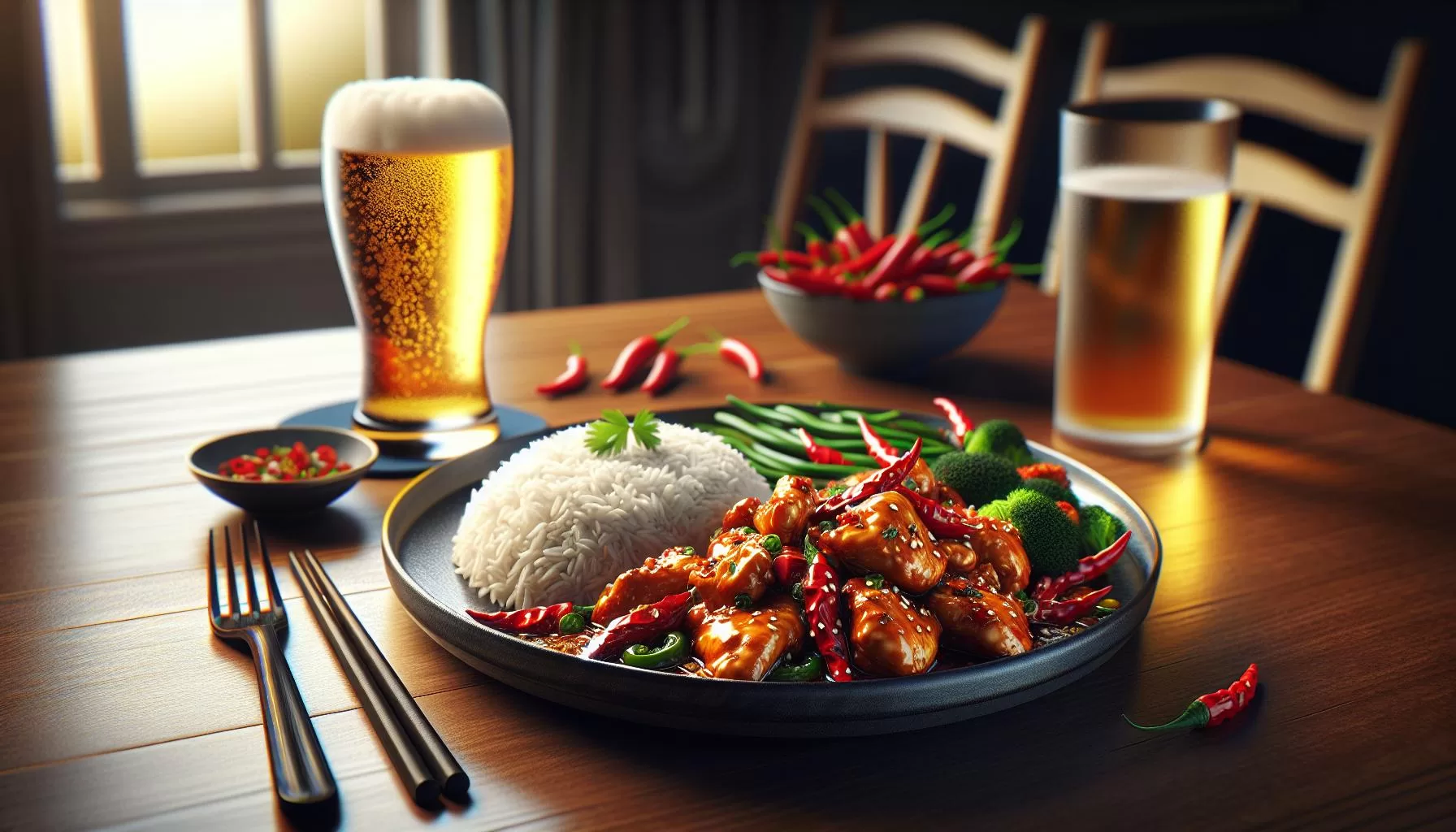Ingredients for Homemade Hunan Chicken
Ready to cook up a storm, and give your palette a piquant ride? Here’s what you’ll need for this zesty recipe.
For the Chicken:
- Boneless, skinless chicken breasts: 500 grams
- Cornstarch: 2 tablespoons
- Salt: as per your taste
- White Pepper Powder: 1/2 teaspoon
Ensure to use fresh and firm chicken breasts. They absorb flavors better and yield a succulent dish.
For the Sauce:
- Chicken Broth: 1/2 cup
- Soy sauce: 2 tablespoons
- Sugar: 1 teaspoon
- Red Chilli Paste: 1 tablespoon
- Rice Wine: 1 tablespoon
- Sesame oil: 1/2 teaspoon
- Garlic, minced: 4 cloves
- Fresh ginger, grated: 1 tablespoon
Using a high-quality chicken broth can elevate the flavor profile of your whole dish. Savory, umami, and a hint of sweet, the sauce is all about balance.
For the Stir-Fry:
- Dried red chilies: 5-6 pcs
- Sichuan peppercorns: 1 teaspoon
- Mixed bell peppers, diced: 1 cup
- Onions, diced: 1/2 cup
- Scallions, chopped: 3 stalks
Don’t shy away from the heat here! Remember, Hunan Chicken should sear and satisfy.
Alternative Ingredients:
Feeling adventurous? Why not tweak your recipe to give it your special signature!
- Replace chicken broth with vegetable broth for a different, yet robust flavor.
- You can use Tamari in place of soy sauce to go gluten-free.
- Opt for honey instead of sugar for a healthier, more natural sweet flavor.
Step-by-Step Instructions
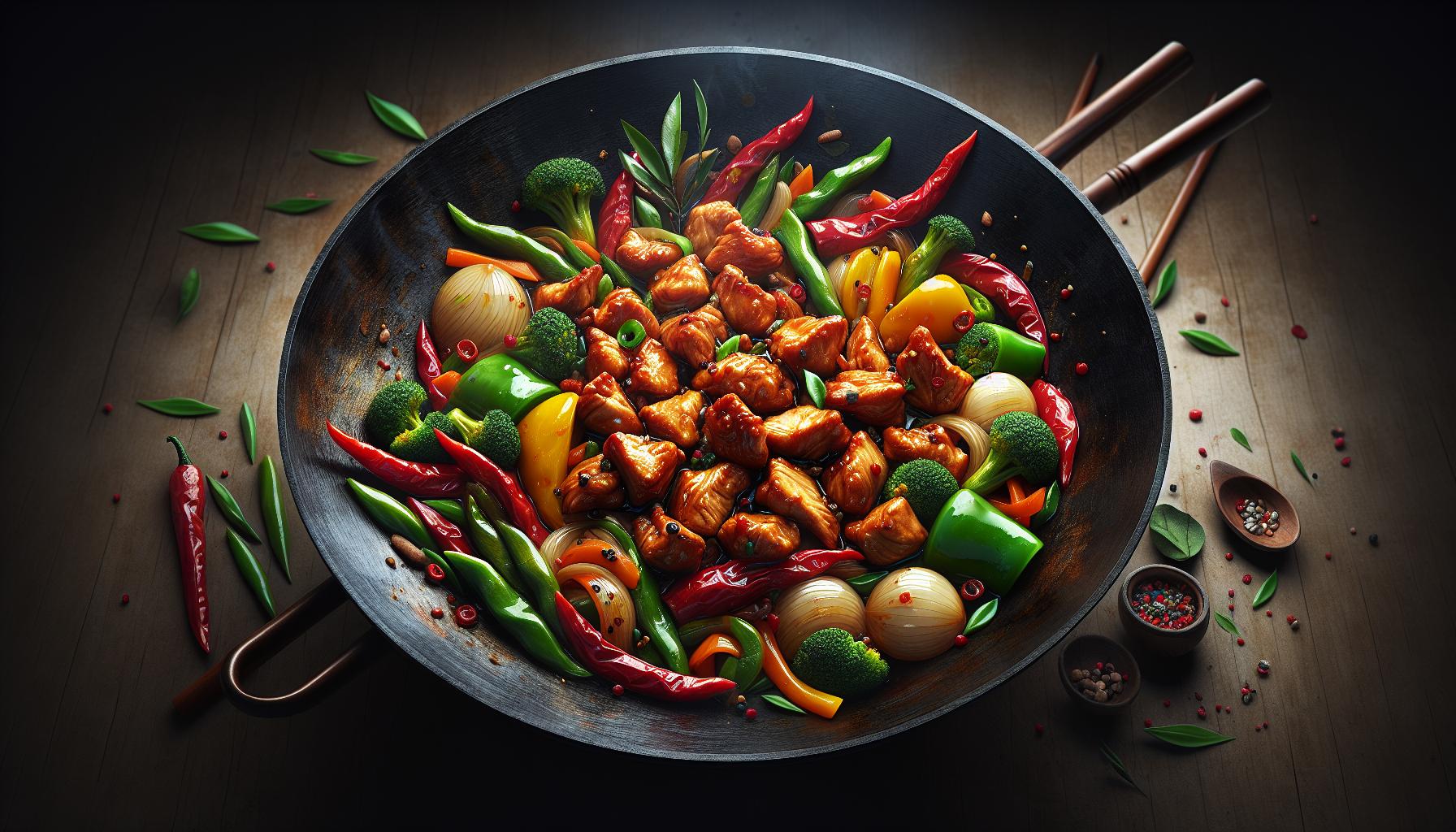
Let’s dive into creating Homemade Hunan Chicken. You’ll find that it’s both a simple and rewarding process.
Prepping the Chicken
Start by cutting your fresh chicken breasts into small, bite-sized pieces. It should be about 2 lbs. Remember, using fresh ingredients elevates the flavors in your dish.
Creating the Sauce
It’s onto the sauce. Combine high-quality chicken broth (1.5 cups), soy sauce (1/3 cup), hoisin sauce (2 tablespoons), rice vinegar (2 tablespoons), cornstarch (2 tablespoons), and sugar (1 tablespoon) in a bowl. If you’re looking to switch things up, consider using vegetable broth in place of chicken broth. Or, you may opt to sweeten your dish with honey instead of sugar.
Stir-Frying the Ingredients
Get your frying pan or wok hot, then add about 2 tablespoons of cooking oil. Toss in the diced chicken and stir-fry until it’s cooked through. Next, add in the vegetables of your choice. Bell peppers, onions, carrots, and snow peas are some great options. Stir-fry these until they’re tender, yet still crisp.
Once that’s done, pour your homemade sauce into the pan. Keep stirring constantly until your sauce thickens up and evenly coats the chicken and vegetables.
For some extra kick, you can sprinkle in a tablespoon of crushed Sichuan peppercorns or a teaspoon of red chili flakes.
Nutritional Value
Many of our readers like to keep an eye on the nutritional facts of their meals. So, here’s a quick breakdown:
| Nutrient | Amount per serving |
|---|---|
| Calories | 450 kcal |
| Carbs | 34g |
| Protein | 33g |
| Fat | 15g |
Homemade Hunan chicken can be a versatile, balanced meal that’s flavorful and nutritious. With these instructions at hand, are you ready to whip up your batch?
Cooking Techniques for Authentic Flavor
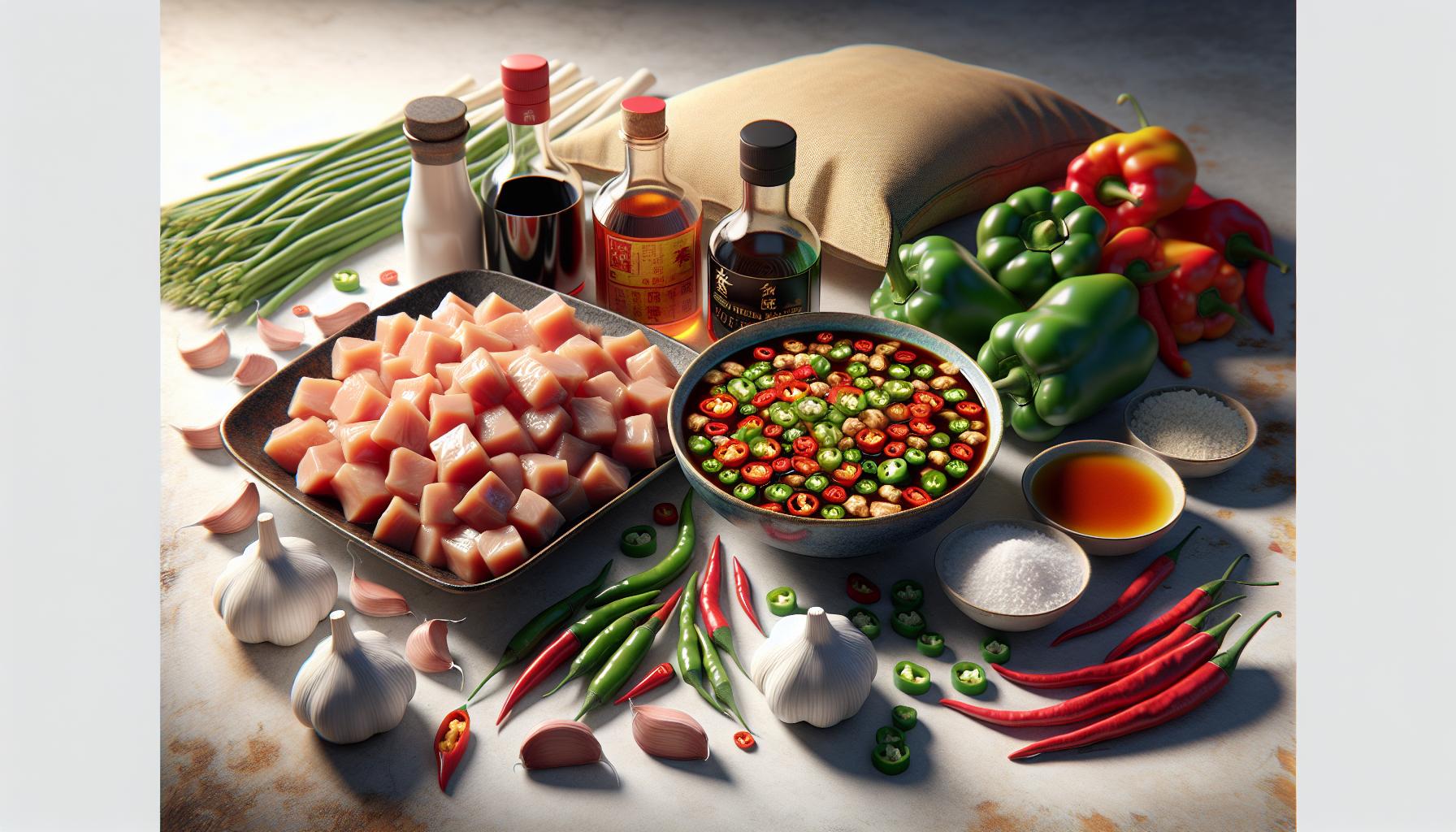
The key to unlocking the authentic Hunan flavor lies in your cooking technique. Precision, timing, and sequence are crucial to achieving that desired taste. Let’s break down these elements.
Start with marinating the chicken. It’s a simple, yet effective way to enrich the flavor. Combine the chicken cubes with soy sauce, cornstarch, and rice wine. Ensure all pieces soak in this mixture for at least 30 minutes. If you’re patient and allow for a longer marination time, you’ll notice a noticeable difference in taste.
Next, we’ll look at the stir-frying process. This technique is integral to Chinese cuisine. The key here is keeping your frying pan over high heat. This keeps the ingredients from stewing and helps them retain their crunch and color. Always remember, when you’re stir-frying the chicken, do it in batches. This approach prevents overcrowding, allowing each piece to cook evenly.
Diving deeper into stir-frying, it’s also crucial to sequence your ingredients. Always begin with ingredients that take longer to cook, like the chicken, followed by vegetables. To enhance the flavor profile, make sure to add the garlic and chilies last, as these ingredients are infamous for burning easily.
Let’s touch upon the sauce. Here’s where you can show off your creativity. Remember, authentic Hunan sauce tends to be quite hot and sour. You can adjust the heat by reducing or increasing chili paste, and balance the sourness with vinegar and sugar to suit your palate. Just remember, when it comes to the sauce, it’s better to add a bit at a time – you can always add more, but you can’t take it away!
Serving Suggestions and Pairings
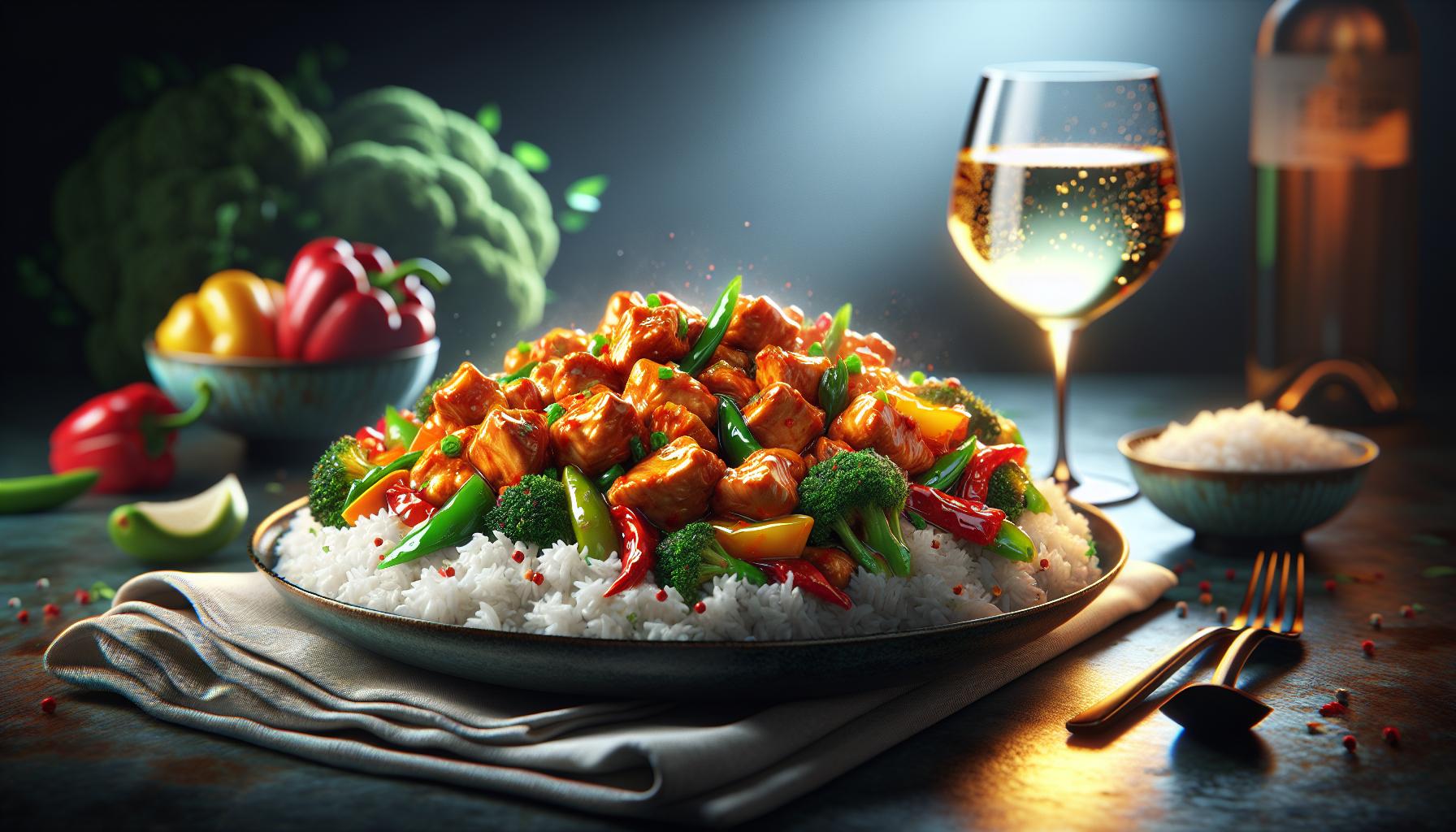
Your homemade Hunan Chicken, bursting with intense flavors, deserves a worthy stage. How you serve this standout, packed with heat and sourness, definitely impacts the overall dining experience. Let’s jump into the aesthetically pleasing and tastebud-tingling ways to present your masterpiece.
Plate your dish on a bed of jasmine rice. It’s a perfect canvas to absorb the robust sauce and adds a delicate floral aroma. A hot bowl of fluffy rice not only rounds out the texture profile but also subdues the punchy flavors, making your Hunan Chicken an utterly delish delight for even the mild-food lovers.
Alternatively, pair this sumptuous stir-fry with Chinese noodles for an authentic oriental affair. Go for either thick Udon noodles that’ll embrace the rich coating, or opt for thin Chuka Soba – it’s your call!
Looking for a low-carb option? Substitute the grains with steamed broccoli or cauliflower rice. They’ll provide a refreshing crunch and tone down the spice, all while keeping the meal light and healthy.
Adding in colorful stir-fried vegetables like bell peppers, zucchini, or snow peas can also elevate the visual appeal as well as the nutritional quotient. And remember, it’s not just about taste, it’s about eating with your eyes too!
Finally, it’s critical to think about the drink that’ll accompany your dish. A glass of light-bodied white wine like Riesling or an off-dry Gewürztraminer can balance the high notes of your Hunanya sauce’s spiciness. If you’re more of a beer person, a cold wheat beer or pilsner would do the trick.
Give each pairing a try. You’ll soon find the combination that transcends your dining experience with homemade Hunan Chicken to an unforgettable gastronomical journey.
Tips for Adjusting the Spice Level
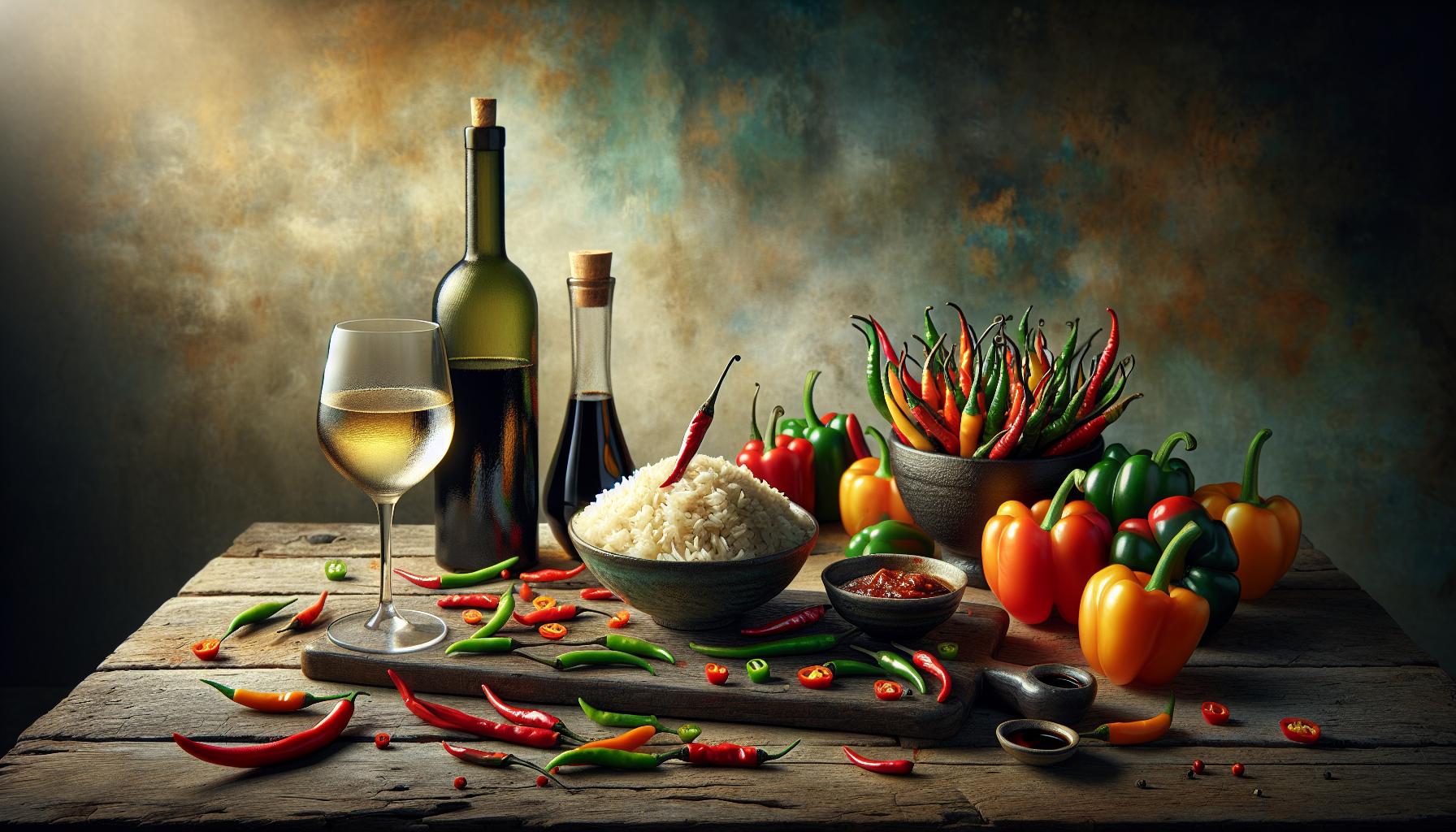
Sweat breaking out on your forehead while handling Hunan sauce? No worries, it’s not that hot. You’ve the freedom to slide the spice scale up or down according to your taste. Here’s how you can do it.
When it comes to the quantity of Hunan peppers, the power is in your hands. A whole pepper will give you a pretty good kick, but if you prefer something less fiery, simply cut down the number. Alternatively, a stealthy method for lowering the heat is de-seeding the peppers before you toss them in. Remember though, this’ll tame the spice, but may also slightly alter the overall taste.
If you’re on the opposite end and possess a palate that craves more fire, you can use hotter varieties of peppers. Ghost peppers, habaneros, or even Carolina Reapers could be suitable if you’ve a strong disposition.
Another handmade tool to manipulate the spice level is the Hunan sauce. You’re fully in control of how spicy you make this. Dial down on the chilli paste or increase the amount of soya sauce to lower the spice levels, and do the opposite if you favor extra heat.
You are not just limited to tweaking the ingredients; you can also play around the serving accompaniments. A bowl of jasmine rice or stir-fried vegetables won’t just add taste and texture, but can help tone down the heat. If you’re more adventurous, serve it with a side of spicy Szechuan dumplings to turn it up a notch.
Also, don’t forget the power of drinks in your arsenal to control the heat. A cold wheat beer or light-bodied white wine can soothe the palate post fiery bites.
The freedom to adjust the spice levels is one of the highlights of this Homemade Hunan Chicken dish. So, go ahead, be bold, and keep experimenting until you find your perfect spice spot.
Conclusion
Now you’re well-equipped to master the art of Homemade Hunan Chicken. Don’t be afraid to play around with the spice level, it’s all about finding what suits your taste buds best. You can dial up the heat with more peppers or tone it down by adjusting the Hunan sauce ingredients. Remember, pairing it with jasmine rice or stir-fried veggies can temper the spice. For those who love a fiery kick, why not try it with spicy Szechuan dumplings? And let’s not forget the drinks. A cold wheat beer or a light-bodied white wine can be the perfect palate soother. So go on, bring the authentic flavors of Hunan into your kitchen and start experimenting. Your perfect Homemade Hunan Chicken recipe is just a cook away.

